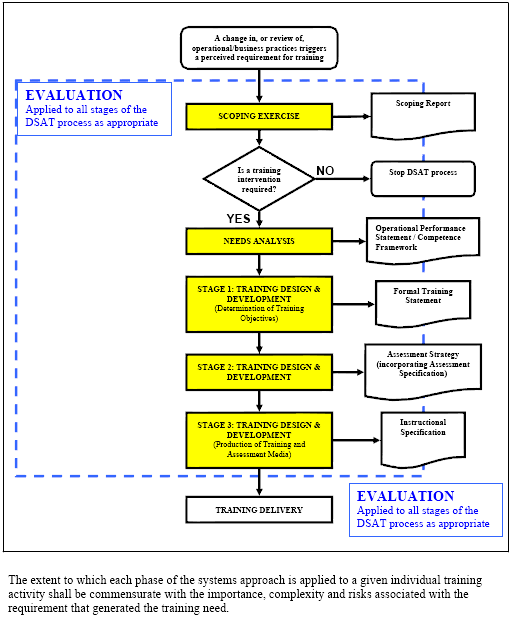Last Updated: 11 January, 2017
Introduction
The Joint Service Publication (JSP) 822 ‘Defence Systems Approach to Training – Direction and Guidance for Individual and Collective Training’, formerly the ‘Governance and Management of Defence Individual Training, Education and Skills’, is the Ministry of Defence (MOD) reference document for individual and (since 2015) collective training management policy and its implementation across defence.
JSP 822 is based on the Defence Systems Approach to Training (DSAT) methodology. The DSAT methodology originated in the mid 1960s by the British Army’s Royal Electrical & Mechanical Engineers (REME), though it was rapidly adopted Tri-Service in different variants and unified during the 2000s (Hone et al., 2009). DSAT is a training quality cycle which is both systemic and systematic, and consists of the following cardinal features:
- Scoping Exercise;

- Training Needs Analysis (change in, or review of, operations/business triggers a perceived need);
- Training Design and Development;
- Training Delivery; and
- Evaluation of Training Effectiveness (encompasses 1-4).
The purpose of JSP 822 is fourfold:
- Specify the governance, policy, processes and procedures that apply to all aspects of the management and delivery of Defence training and education.
- Provide policy and direction to those involved with setting and validating the requirement for training; course design, development and delivery; and all forms of assurance.
- Define the DSAT Quality Standard (QS) to which training is to be managed and form the basis for any outsourcing contracts for training functions.
- Provide recommended guidance to meet the DSAT QS to encourage a coherent approach across Defence and be a source of ‘good practice’ to optimise training across Defence.
Since 2015, the JSP 822 has been consolidated into two documents:
- JSP 822: Defence Systems Approach to Training – Direction and Guidance for Individual and Collective Training. Part 1: Directive. v2.1 (December 2016).
- JSP 822 – Part 01, Directive v2.1 (2016-12-12)
- JSP 822: Defence Systems Approach to Training – Direction and Guidance for Individual and Collective Training. Part 2: Guidance. v2.1 (December 2016).
- JSP 822 – Part 02, Guidance v2.1 (2016-12-12)
Both documents can be found within the MOD section of the UK Government-wide website: gov.uk.
With the introduction of the new two-part JSP, there are now five Defence Directions relating to DSAT:
- Defence Direction for Training Systems;
- Defence Direction for Individual Training;
- Defence Direction for Collective Training;
- Defence Direction for Trainer Capability (underpinned by the Defence Trainer Competence Framework); and
- Defence Direction for Technology Enhanced Learning (TEL), the Defence Learning Environment (DLE) and Simulated Training.
A significant change in the document (and Defence in general) is the term Trainer (considered student-centred) subsuming the term Instructor (considered didactic), to align with the professional terms used in further education.
Prior to 2015, the JSP 822 was divided into six parts as listed below:
Governance & Management
Part 01: Introduction (Issue 2.1, June 2012): JSP 822 – Part 01
Part 02: Training & Education Glossary (Issue 1.0, January 2012): JSP 822 – Part 02
Part 06: The Defence Training & Education Capability (DTEC) Rules (Issue 1.1, 16 February 2014): JSP 822 – Part 06
Relating to DTEC:
- The Interim Defence Simulation Centre (iDSC) of the Defence Academy of the United Kingdom: an additional role of the iDSC is to support the outputs of the DTEC programme focussing on enabling better, cheaper and more environmentally sustainable training to Defence. View http://www.da.mod.uk/dsc and http://www.ltpa.co.uk/capabilities/dsc/index.asp.
- The DSC Industry Advisory Group (DIAG): DIAG supports the objectives of the DETC in establishing an effective and capable DSC (see above) by providing a mechanism for knowledgeable and representative bi-directional engagement with industry and academia at all effective levels. View http://www.da.mod.uk/dsc.
Training Management Policy
Part 03, Chapter 01: The Governance of Joint Training & Education Requirements (Issue 2.0, January 2012): JSP 822 – Part 03, Chap 01
Part 03, Chapter 02: The Management of Individual Training & Education (Issue 2.1, June 2012): JSP 822 – Part 03, Chap 02
Part 03, Chapter 02, Annex A: Compilation of Statement of Training Requirement (SOTR) (Issue 2.1, June 2012): JSP 822 – Part 03, Chap 02, Annex A
Part 03, Chapter 02, Annex C: SOTR Throughput (Issue 2.1, June 2012): JSP 822 – Part 03, Chap 02, Annex C
Part 03, Chapter 03: The Assurance of Individual Training & Education (Issue 2.0, January 2012): JSP 822 – Part 03, Chap 03
Part 03, Chapter 04: Defence Training Policy for Staff Delivering Formal Training (Issue 1.0, July 2008): JSP 822 – Part 03, Chap 04
Part 03, Chapter 05: Learning Technologies (Formerly Known as Technology Based Training) (Issue 1.0, January 2012): JSP 822 – Part 03, Chap 05
Part 03, Chapter 06: Defence Individual Training Management Information System (TMIS) Policy (Issue 1.0, June 2012): JSP 822 – Part 03, Chap 06
Part 04: DSAT QS 001:2008 (The Defence Systems Approach to Training Quality Standard) (Issue 1.0, December 2008): JSP 822 – Part 04. This describes the DSAT process.
Defence Training Support Manuals
Part 05, Chapter 05: Learning Technologies Handbook (Issue 1.2, January 2012): JSP 822 – Part 05, Chap 05
Part 05, Chapter 07: Methods & Media Selection Tool User Manual (Issue 1.0, January 2012): JSP 822 – Part 05, Chap 07
DSAT in Practice
For a practical example of DSAT please view DSAT, The ASPT Story (2012).
References
Hone, G., Whitworth, I., Farmilo, A. & Swift, D. (2009) Validating a Scenario Assessment Tool. Available from World Wide Web: http://www.dodccrp.org/events/14th_iccrts_2009/papers/071.pdf. [Accessed: 07 September, 2014].

